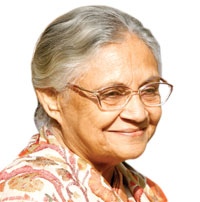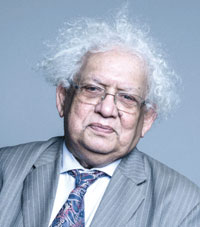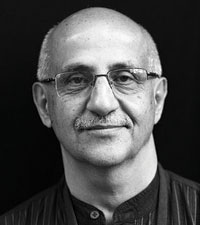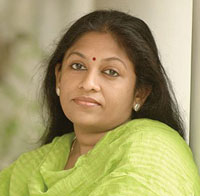We are a nation of stories. Besides our major epics, stories have sprouted around our numerous gods, each constituting a mini-epic. As a people, we read the stories of our gods, we have them read and interpreted, we have them performed in more regional and linguistic variations than we can count. Some of these forms have traditions so hoary they are accorded the status of classical arts. Some others, more robust and flexible, take on the air of the folkloric. Somewhere in the middle of all this lies the 20th century form called the feature film.
In India, it had its beginnings on the stage -- the itinerant drama troupe, in fact. One only need watch a few old films to realise how much of it was nothing more than the stage, caught on celluloid and rendered on screen. And as a people, we have related to films with the same enthusiasm, thrall, and joie de vivre that villagers have had for the drama troupe.
Like any fiction, the storytelling in our films has drawn on reality. Our films have thus reflected what is happening around us and have, to a greater degree than we would believe, influenced our behaviour. Even politically. We have possibly sent more persons from films into our legislative bodies than most other nations. Some of our southern states have had filmstars as chief ministers. They were no lightweights and have proved themselves in political astuteness and unparalleled popularity. Even those who haven’t become chief ministers have had such strong following that mainstream political parties have often had to strike deals with them.
While many of our films are about pure entertainment, there are enough of them that reflect on society. In fact, a list of stock characters and tropes from films would reflect prevalent stereotypes: the vicious, double-dealing cop or politician, the big businessman who doesn’t care about his workers’ lives, the honest cop who finds himself fixed by politicians, the angry young man (albeit a borrowing from John Osborne), the social reformer triumphing over all odds. Equally, over the ages, our films have addressed the problems of society without flinching: casteism, rape, superstition, child marriage, religious strife, riots, rural distress. There’s hardly any problem our cinema has left unaddressed (though there is enough to be said about the films not being blunt enough).
In the process, some films, more than others, have come to reflect particular periods in the nation’s life. Their influence -- perceived influence, one might say -- is not insignificant. Governments have felt threatened enough to ban or hold up films like Kissa Kursi Ka and Aandhi.
For this Independence Day special issue, we decided to go for a simple list-based format. We asked well-known personalities a simple question: Which films made since Independence have defined India and the Indian condition? We hope you’ll find their answers interesting, thought-provoking. Any list is open to the charge of bias, of ignoring something important, or emphasising what is trivial. So we will look forward to our readers emailing us their own lists.
Manish Sisodia,
Deputy CM, Delhi

Mulk: About a Muslim family struggling to keep its honour intact after a member takes to terrorism.
Hichki: A teacher with Tourette syndrome (played by Rani Mukherjee) is told to teach a group of underprivileged children. She succeeds.
PK: An alien gives Indians some lessons on religious harmony.
3 Idiots: Based loosely on Chetan Bhagat’s book Five Point Someone, this film is a quirky send-up of the Indian education system, set in that mecca of studious achievement -- an IIT.
Pink: A touching drama -- also a courtroom drama -- about a woman’s right to say no.
Raajneeti: The Mahabharata set in an Indian political mileu.
Peepli Live: The film explores the media circus around farmer suicides.
Hum Aapke Hain Koun: A light-hearted family drama, it grossed over $92 million worldwide.
Shiela Dikshit,
Ex-CM, Delhi
“These movies reflect or represent the times they were made in – they became the signature movies of those times. They have beautiful songs too, and the characters were dignified and portrayed beautifully by the artistes.”
 Gandhi: “I’ve seen this movie 10 times, at least,” says Sheila Dikshit.
Gandhi: “I’ve seen this movie 10 times, at least,” says Sheila Dikshit.
Abhimaan: A singer marries a simple village girl who can sing and is unable to take it when her career flourishes while his faces a setback.
Chaudhvin Ka Chand: Produced by Guru Dutt and directed by Mohammad Sadiq, this black-and-white classic set in Lucknow explores a love triangle. Mohammad Rafi’s rendering of the title song is the Kohinoor ornamenting moonlit romance, captured brilliantly by cinematographer VK Murthy.
Guide: RK Narayan’s novel, as envisioned for the screen by Chetan Anand, with Dev Anand playing the guide. SD Burman’s music enthralls
Piku: A comedy-drama about an old man’s eccentricities and his daughter’s struggle to come to terms with it.
Jab We Met: Written and directed by Imtiaz Ali, it’s a romance with a number of twists that won a million hearts.
Madhumati: The classic supernatural film, about a past-life romance cut short. Directed by Bimal Roy, script by Ritwik Ghatak.
Silsila: A romantic drama, again one involving multiple connections, like Kabhi Kabhie.
Raazi: Alia Bhatt plays a spy who is married into a top Pakistani general’s house to get valuable information that will help India sail through a war.
Dilwale Dulhania Le Jayenge: “I’ve seen this 20 times,” says the former chief minister of Delhi.
Kabhi Kabhie: A tangle of romances, it marked the detour for Amitabh Bachchan from his earlier ‘angry young man’ roles.
Sholey: “I’ve seen it countless times,” says Sheila Dikshit
Pyasa: Guru Dutt’s black-and-white classic tells the love story of a poet unable to come to terms with the commercial side of publication.
Saheb Biwi aur Ghulam: Another classic, with Guru Dutt playing the servant of an alcoholic woman ignored by her husband.
Padosan: A riot of a comedy.
Raghubir Yadav
Actor

Think of screen characters from small-town India, and the NSD-trained Raghubir Yadav comes to mind, essaying those roles with authenticity and elan. Here’s his list of films that have defined India:
Mother India: Technicolour drama about a woman’s relationship to her land that raised its protagonist Radha, played by Nargis, into the apotheosis of Indian womanhood.
Upkar: This film, brimming with nationalistic spirit, was the first of Manoj Kumar’s appearances as a character named Bharat; also noted for him playing both a kisan and a jawan.
Do Bigha Zamin: Drought, rural debt, migration to cities in search of work, sale of agricultural land to industry – the problems addressed in this tragedy seem as true today as they were in 1953, when this film was made by Bimal Roy.
Purab Aur Paschim: Another patriotic film, again with Manoj Kumar as Bharat, it set the East-West dichotomy of stereotypes in stone.
Kabuliwala: The well-known Rabindranath Tagore story, vitalised on film by Bimal Roy, with Balraj Sahni playing Abdul Rahman Khan.
Haqeeqat: The 1964 Chetan Anand film about India’s disastrous 1962 war with China, with the classic beauty of Priya Rajvansh a counterpoint to the harsh realities of war in a Himalayan setting.
Massey Sahib: Raghubir stars in the title role, as a rule-bending assistant in a British collector’s office. In the end his boss is unable to – or perhaps will not – save him. There’s also Arundhati Roy, playing his love interest and wife.
Haqeeqat: The 1964 Chetan Anand film about India’s disastrous 1962 war with China, with the classic beauty of Priya Rajvansh a counterpoint to the harsh realities of war in a Himalayan setting.
Nishant: Shyam Benegal’s film captures the oppressive feudalism of the 1940s in a rural setting.
Ankur: Benegal’s debut film, again in a rural setting, that marked the advent of ‘New Cinema’, now also termed ‘middle cinema’.
Peepli Live: Satire on farmer suicides and how the media turns them into tamashas.
Samar: This 1999 Hindi film, also by Benegal, is as much a film about casteism in India as it is a film about film-making.
Medha Patkar
Activist
 As an activist, Medha Patkar has worked among slum-dwellers, tribespeople and those displaced by big dam projects such as those on Narmada. Her choice of films capturing India, reflects her sympathies.
As an activist, Medha Patkar has worked among slum-dwellers, tribespeople and those displaced by big dam projects such as those on Narmada. Her choice of films capturing India, reflects her sympathies.
Gaman: Muzaffar Ali’s brooding look at migration from villages to cities and the alienation suffered by poor migrants in big cities like Mumbai. Urban angst resonates in the song ‘Seene mein jalan’, written by Shahryar and sung by Suresh Wadkar.
Tuhya Dharma Koncha?: A Marathi film by Satish Manwar on tribal families torn between social and religious organisations trying to win them to their fold.
Milind Deora
Member of Parliament

“For me, two films convey India’s reality and culture best: the first is from the black-and-white era, and the second was made when Indian culture achieved technicolour.”
Do Ankhen Barah Haath: About an open jail experiment which transforms hardened criminals into upright citizens through hard work and kind guidance.
Dangal: A wrestler’s struggle to see his daughters win medals on the mat and bring laurels to the nation.
S Irfan Habib,
Historian
 Garm Hava: “This has to be my foremost pick. It is a poignant film which depicts the impact of partition not only on India but also on Pakistan. The partition has still not left us, we still see its effects,” says the noted scholar.
Garm Hava: “This has to be my foremost pick. It is a poignant film which depicts the impact of partition not only on India but also on Pakistan. The partition has still not left us, we still see its effects,” says the noted scholar.
Pakeezah: “Films like this depicted history and were also entertaining. These films cannot be made today. Earlier, it used to take years to produce a movie, now with the technology everybody is in a hurry to produce a film.”
Shree 420: “Raj Kapoor movies depicted romance which we had with the idea of an independent India. This looks untrue today. These movies cannot be replicated today. Today we are dividing the country in getting together. We have a very cynical view now and look for new issues to divide the country. We get into new mess every day.”
Lord Meghnad Desai,
Economist and Commentator
 "My knowledge of Indian films is very much about the fifties as I left India in 1961. My knowledge of the other decades is sparse... I will concentrate on the things I know best.”
"My knowledge of Indian films is very much about the fifties as I left India in 1961. My knowledge of the other decades is sparse... I will concentrate on the things I know best.”
Andaz: The 1949 film directed by Mehboob Khan showcased “attack on Westernisation as the danger to Indian family life.”
Mother India: “An epic film [about] a woman’s struggle against patriarchy and money power.”
Awara: The Raj Kapoor starrer pointed out “the income divide starkly by filming slums and palatial houses and doubting the idea of birth as a mark of virtue.”
Naya Daur: The film that helped Dilip Kumar bagged a Filmfare Award portrays “the man versus machine challenge in rural development.”
Pather Panchali: A 1955 Indian Bengali-language classic written and directed by Satyajit Ray
Pyaasa: Produced and directed by Guru Dutt, the 1957 film also features him in the lead role. The movie shows “disappointment with the first ten years of independence.”
Mughal-e-Azam: “A definitive film of the Nehruvian ethos”
Gautama the Buddha: The film is “a beautiful piece, an outstanding Indian historical film”
Ankur: The film showcases “new India struggling to be born in defiance of old India”
Suresh Prabhu
Union Minister of Commerce and Industry and Civil Aviation

“Out of hundreds of movies produced in India every year, only a few strike perfect balance between the heart and mind – having both entertainment and thought. Especially, two movies that I watched, Mother India and Jis Desh Mein Ganga Behti Hai, reflect the spirit and culture of post-independent India. The first one talks about the dream that is India and the second depicts the exuberance required to fulfil that dream.”
Harsh Mander
Human Rights and Peace Worker, Writer and Researcher
 Mahanagar: The 1963 Bengali drama, written and directed by Satyajit Ray, portrayed the role of women in a new India.
Mahanagar: The 1963 Bengali drama, written and directed by Satyajit Ray, portrayed the role of women in a new India.
Naseem: Directed by Saeed Akhtar Mirza, the film is set in time preceding the demolition of Babri Masjid in Ayodhya
Meghe Dhaka Tara: Written and directed by Ritwik Ghatak, the film deals with the aftermath of the partition of Bengal
Mathilukal: Directed and produced by Adoor Gopalakrishnan
Kaaka Muttai: The Tamil-language comedy-drama was written and directed by M Manikandan. The film revolves around the aspiration and desires of two slum children.
Amish tripathi
Writer

Swades: “It is an earnest film by Ashutosh Gowarikar. Not only the old elite but post 1991 lives of many in India have improved dramatically. How many of us have really gone out of our way to give back to our country? Swades did that in a very gentle and inspirational way. To me that is dharma. When your country has helped you achieve so much, then dharma says you have to give back and give to those fellow countrymen who are still suffering. I feel it is Shahrukh Khan’s best performance.”
Dangal: “On the surface it is a sports film, on a deeper level it is about the new can-be spirit of India. For most of our ancient history we were world leaders and interacted with the world leaders with confidence and were the best in many areas. In the last few centuries due to invasions, we had become very insecure and diffident. We either behaved very servile or unnecessarily aggressive. Dangal, in my mind, showed resurgence of confident India, which is not fighting but to actually play hard to win.”
Ramesh Sippy
Filmmaker
 Director of the blockbuster Sholay, and virtually the king of Bollywood at one time, Ramesh Sippy’s choices touch on the entire range of Bollywood – from the social drama of Do Beegha Zamin to the romatic Prem Rog:
Director of the blockbuster Sholay, and virtually the king of Bollywood at one time, Ramesh Sippy’s choices touch on the entire range of Bollywood – from the social drama of Do Beegha Zamin to the romatic Prem Rog:
- Padmavat
- Ek Duje Ke Liye
- Ek Chadar Maili Si
- Dangal
- Mughal-e-Azam
- Hum Aapke Hain Koun
- Charulata
- Pakeezah
- Prem Rog
- Lunch Box
- Do Bigha Zamin
- Dum Laga Ke Haisha
- Mother India
MK Raina,
Actor

“If we talk about popular cinema, I don’t think that after ‘Mother India’ and ‘Gandhi’ there are any films that have depicted India in its true sense. Cinema today has become the cinema of the upper middle class, which is in a minority. Cinema today is the cinema of illiterates made for illiterates. Filmmakers know what sells: their concern is crossing Rs 100 crore.”
 Sanjay Mishra
Sanjay Mishra
Actor
Garm Hawa: Based on partition of India and communal disharmony prevailing after that, this film depicts the harsh reality of those times
Mere Apne: It depicts the nihilism felt by youth post-independence
Roti Kapada aur Makaan: This film has very well depicted the survival struggle prevailing in the country
Kadwi Hawa: This is important because this is the first detailed film on climate change and its connection with the farmers.
Jai Santoshi Ma: It was not very great in terms of acting, camera or any other craft. But it was important because people supported it. It led to construction of temples. It shows the connection of the Indian audience with the cinema
Pushpesh Pant
A former professor of international relations at JNU, Pushpesh Pant is popular as the author of 'India: The Cookbook.'

Garm Hava: M.S. Sathyu’s film boasts sterling credits: Screenplay by Kaifi Azmi and Shama Zaidi, based on a short-story by Ismat Chugtai; music by Ustad Bahadur Khan; lyrics by Kaifi Azmi. It deals with the post-Partition trauma of Muslim families that decided to stay back in India.
Swayamvaram: Adoor Gopalakrishnan’s debut film about the struggles of a young couple who are unable to find a sure footing in life.
Arvind Gaur
Dramatist
 Actor and dramatist, Arvind Gaur is known for staging plays that touch upon social issues, including communalism, casteism, domestic violence, and state violence.
Actor and dramatist, Arvind Gaur is known for staging plays that touch upon social issues, including communalism, casteism, domestic violence, and state violence.
Mother India and Do Bigha Zamin: These two films depicted post-Independence India and its problems.
Garm Hava: It was true to India's partition and communal violence
Jane Bhi Do Yaron: This film depicted corruption in politics and bureaucracy in a satirical manner
"Satya, Salaam Bombay, Ardh Satya and Black Friday and other great films"
"The films that are being made today, they are inspired by these older films. Lagaan, Swadesh, Gangs of Wasseypur, Madras Cafe – these are some of the films."
Prithviraj Chavan
Former CM, Maharashtra
 Chak De! India: “The ‘Can do’ attitude propels India as a sports success story.”
Chak De! India: “The ‘Can do’ attitude propels India as a sports success story.”
Three Idiots: “A very telling commentary on the current state of higher education.”
Saamana: “An outstanding Marathi film on the cooperative movement and rural leadership in Maharashtra.”
Manthan: “The Gujarat cooperative dairy industry is showcased.”
Guide: “RK Narayan’s classic novel on a modern-day godman converted into a powerful film.”
English Vinglish: “Female empowerment within the parameters of a typical Indian conservative family.”
Garm Hava: “The movie depicts the struggles of a Muslim businessman, soon after the partition, [which ] is very relevant today.”
Mother India: “An all-time classic, portraying the power of motherhood.”
KR Meera
Writer
 Mahanadi: The 1993 Tamil movie deals with the issue of corruption and child trafficking. The movie was dubbed in Telugu with the same title. It even won the national film award for best feature film in Tamil.
Mahanadi: The 1993 Tamil movie deals with the issue of corruption and child trafficking. The movie was dubbed in Telugu with the same title. It even won the national film award for best feature film in Tamil.
Piravi: The 1989 Malayalam feature film directed by Shaji N Karun is inspired by the life of professor TV Eachara Warrier, whose son, an engineering student, was believed to have been murdered in 1976, during the Emergency period. The film won at least 31 awards.
Bombay: The 1995 Tamil language drama directed by Mani Ratnam, centered around the increased religious tensions in the city of Mumbai after the demolition of Babri Masjid in Ayodhya.
Jalsaghar: The Satyajit Ray film focuses on the zamindari system in Bengal.
Salaam Bombay: Mira Nair's directorial debut chronicles the daily lives of slum children in Mumbai.
A Wednesday
Mother India
Ananth Mahadevan,
Actor, director

In India, films on patriotism are directed more at whipping up audience frenzy rather than subtly driving home a sense of national pride. Some earlier films, like Shaheed (1965) and Chetan Anand’s Haqeeqat (on the Indo-China war) succeeded to a great extent in balancing dramatic elements and at the same time evoking a cry for the country. Manoj Kumar, however, raised patriotic cries to the level of jingoism, whether in Purab Aur Paschim or Kranti.
“Patriotism is also generously sprinkled in films depicting actual events (Airlift), biopics (Bhag Milkha Bhag) and even formula films (say Manmohan Desai’s Desh Premee). That it rings false and forced is hardly a deterrent to filmmakers: they fail to take a cue from Hollywood films like Patton or others about the World War II.
“My stint with the freedom struggle as a filmmaker began with a biopic on the life of Gour Hari Das, one of the last living freedom fighters. His 35-year struggle for a freedom fighter certificate depicted the irony of a modern India questioning the credibility of one of its own founders. The film, Gour Hari Dastaan – The freedom file, was a quiet, almost silent depiction of the state of a nation and its people. Das was soft-spoken, and this brought a new metre of subtlety to the film. This made it stand out as an off-beat ode to patriots and the nation.
Sudhir Mishra
Filmmaker

"In the 1950s, Mehboob Khan, Bimal Roy, Raj Kapoor, Guru Dutt, BR Chopra, Mehboob Khan and others made films expressing Nehruvian ideas of progress. They tackled burning social issues of the time and helped in breaking the shackles of feudalism. Chopra’s Naya Daur and Mehboob Khan’s Mother India dealt with ordinary people’s struggles against feudalism, their failures, their frustrations, their dreams of success and their attempts at finding a voice.
In Pyaasa, Guru Dutt asked many important questions in the song ‘Jinhe naaz hai Hind par woh kahan hain?’ In the political class, the establishment of the time, he found a betrayal of India: those who came to power after independence had not kept promises made to the people. Mughal-e-Azam harked to our past glory.
The 1960s saw frivolity in our films. Films were lighter. They just shut their eyes and moved away to some hill-station to find romance and love. By the 1970s, dreams soured and many social movements took root in India. Salim-Javed wrote stories of angry young men, of revolt, of people losing faith in the justice system. People asked questions. They also depicted a parallel system, with gangsters as heroes.
With the economy opening up in the 1990s, India became an aspiring, consumerist country – ideas relating to that began to sell. The NRI market opened up, so Indian films reflected on those issues. Swades is about a hero coming back to understand the problems of the country.
Now we are back again to asking questions, especially those asked by filmmakers from small towns. Mulk, for example, asks lots of questions. My film Hazaron Khwaishen Aisi or Anurag Kashyap’s Mukkebaz, or films by Vishal Bhardwaj are rooted in the current problems of the country. Films like Dangal depict aspirational heroes. With India on the move, it’s also an era of biopics: of heroes achieving individual dreams, because the collective dream has vanished."
Nandita Das
Actor

- Garm Hava
- Do Bigha Zamin
- Mother India
- Pather Panchali
- Mukha Mukham
- Iruvar
- Ardh Satya
- Jaane Bhi Do Yaaro
- Manthan
- Akaler Sandhane
- Firaaq
